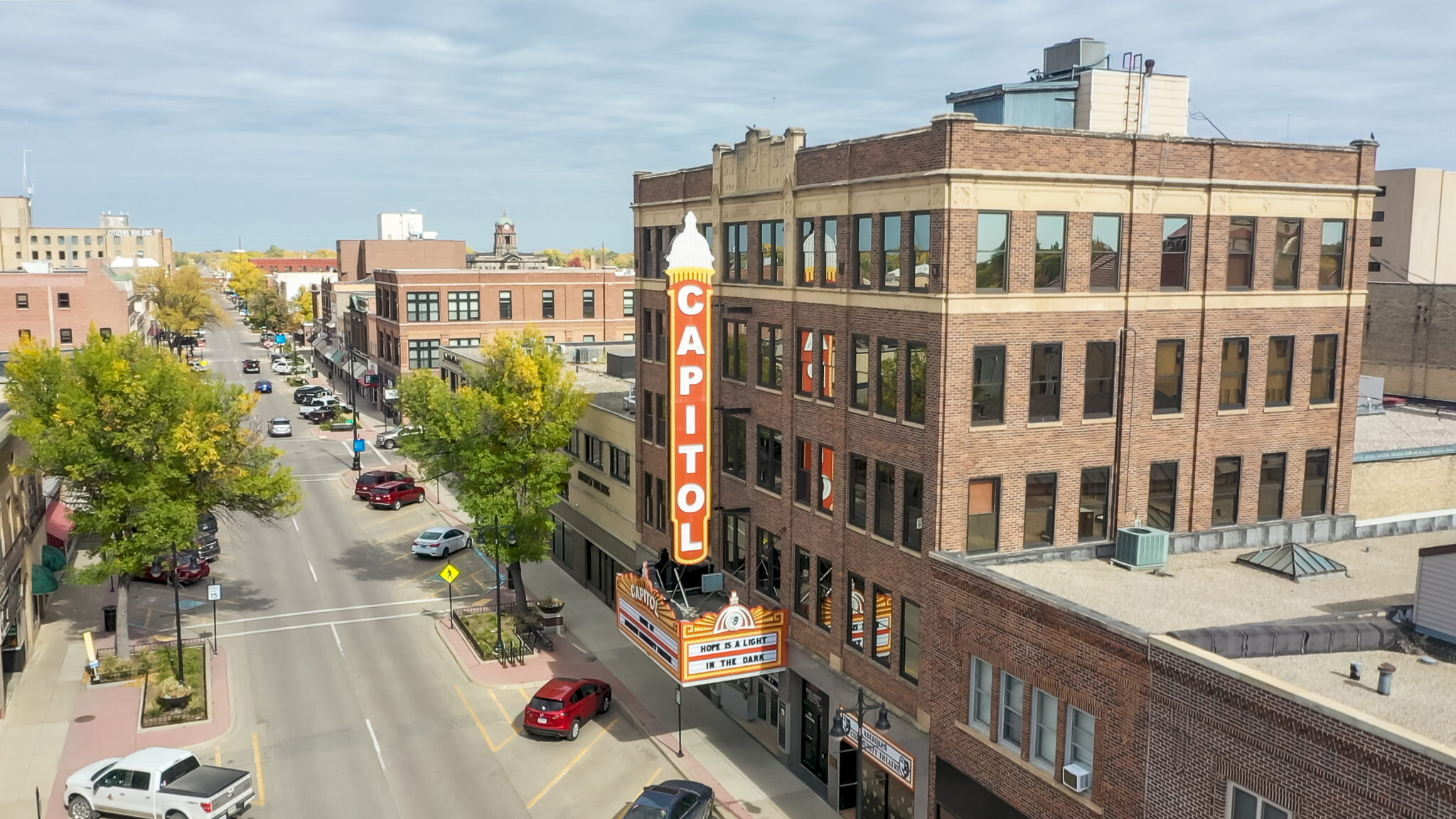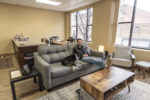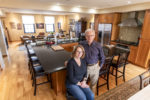

“If you build it, they will come.” When they summarized how expanding downtown housing would work in Aberdeen, almost everyone I spoke with for this story did their best Kevin Costner impression. Okay, actually, they unintentionally paraphrased his “Field of Dreams” speech in their own voices. Another theme was more, more, more. More downtown apartments means more people means more businesses means more employees means more tax revenue means, well, more. So how might this downtown of dreams materialize?
There’s definitely room for growth in upstairs downtown. Heath Johnson, of Dakota Plains Commercial Real Estate, said the vacancy rate in downtown apartments is “effectively zero.” He admitted that’s an educated guess, but he pays attention to how quickly available apartments get rented. There’s no solid count of the number of apartments in rentable condition on Main Street, but he estimated it at about 110 (this increases to about 160 if he expands his scope to the Downtown Business Improvement District [BID], which generally includes the two blocks on either side of Main Street between Sixth Avenue and the railroad tracks with an extension over to Central Park, the Roosevelt Apartments, and the library). Thus, the Malchow’s fire, which took 17 apartments out of the inventory, reduced Main Street capacity by about 15 percent. Spencer Sommers, design architect at Co-Op Architecture, said the firm did a rough estimate that found buildings on Main Street are using maybe one-third of their potential capacity for apartment space, suggesting room for perhaps 130 more apartments.
If You Build It, They Will Come
But why focus on downtown apartments? According to Aberdeen Development Corporation CEO Mike Bockorny, it’s where people want to live. Plus, he said, it takes advantage of a unique asset for a town the size of Aberdeen. “Our strength in having two four-year colleges is key. We need to keep as many graduates in our community as we can so they can fill jobs, create businesses,” and generally contribute to the city.
Mike pointed to research from a New Hampshire organization that focuses on rural and smaller cities. “They conducted a survey that found 50% of people in communities with populations under 50,000 prefer a walkable life, where you can walk from your home to your everyday needs. Also, the same poll reports 70% of people under age 30 prefer a walkable life and want to live downtown.” What counts as walkability? Mike lists proper sidewalks, crosswalks, landscaping, lighting, seating, public art, facade improvements, and green space, among other amenities. He added that it’s not just for recent college graduates. The same survey said 20% of retirees desire a walkable life, a number that’s expected to increase to 40% over the next 15 years.
Confirming the demand for downtown housing, Shelley Westra-Heier, Aberdeen Downtown Association executive director, said after the fire that destroyed their homes, “Several Malchow’s tenants called me to find other places to live downtown.”
If They Come, They Will Build Businesses
“It’s the whole work/live/play concept,” Shelley explained. “When people live downtown, they have needs, like restaurants, a place to grab a drink, places to buy things. They bring additional foot traffic. If people live downtown, it’s where they play and shop. People attract people and businesses. That’s economic development for downtown.”
Jeff Mitchell, executive director of Homes Are Possible, Inc. (HAPI), asked rhetorically, “If you can bring 40 apartments downtown, what’s that do for getting a new restaurant or drugstore downtown?” The implied answer is “a lot.”
Heath summed it up, “At the end of the day, if you have people that live here, they’ll spend more of their time and money in the core. I think it’s key. Having more apartments and downtown dwellers will drive demand for more business downtown.” The potential is there, he said. “We need more households downtown.”
Besides the benefits new apartments bring to downtown as a whole, Shelley noted an essential factor in this equation. If a building owner’s business is on the ground floor, “Part of the success of a main-floor business might be that it’s subsidized by second-floor rents.” She added, “A key is to get buildings in the hands of the right owners who see that vision as well.”
If They Build It, It’s Going to Cost
Heath believes, “We could probably double or more the number of apartments downtown if the currently unusable apartments were fixed and other spaces were converted.” But he added, “Building codes and fire code are major issues. Many buildings downtown were built before the codes were in place. Retrofitting buildings to meet code can be difficult.” He knows this from experience, having been part of the group that bought the Olwen-Angell building on the northeast corner of Fourth Avenue and South Main (the Anytime Fitness building) and converted the upper floors into apartments.
That project added 14 new apartments downtown, and it was a considerable undertaking, including the installation of a new elevator. The one-time department store had a small elevator, but it didn’t serve apartment living needs. Besides addressing fire and building code issues, plus Americans with Disabilities Act requirements, there were additional obligations involved with converting the building from nonresidential to residential use. It paid off, and it could be a model for other projects and developers. But Heath added, “The need is to solve the problems of cost. It needs to make sense financially for an owner.” He also mentioned the issue of downtown parking, but more on that later.
Second-story housing is a significant focus of the BID, Shelley noted (another hat she wears is executive director of the BID). They are working to “help break down some of the barriers building owners are running into and gathering resources that could help them see their second-story project become a reality.” She added that it’s “disheartening” when a building owner is unable to finish a project “because of a code or ordinance issue that put a financial barrier in their path that they just can’t get around.”
If You Build It, They Will Lend
The Olwen-Angell project caught Jeff Mitchell’s attention because it was fully rented almost immediately. Known for building homes around Aberdeen, HAPI has been thinking about downtown apartments for years. About six years ago, HAPI and the Aberdeen Downtown Association received a grant from the John S. and James L. Knight Foundation to study the costs of creating residential space in the upstairs floors of downtown. “The idea was to create a template for an owner to convert their building into apartments,” Jeff said.
That report considered an actual two-story downtown building. Jeff remembers the building’s upstairs having “about 30 doors connecting many small offices,” meaning the hypothetical project would require gutting the whole floor. The Northeast Council of Governments conducted the study. Its 2015 report estimated that converting this upstairs office space into six apartments would cost $400,000, expenses that would not include an elevator since that ADA requirement only applies to buildings taller than two stories. Considering both financing expenses and rental income, the report concluded the project would provide net income immediately, which would grow over time.
A Community Development Financial Institution (CDFI), HAPI can be one route to get there. Jeff said HAPI has earmarked $500,000 of its CDFI funds to support apartment development in Aberdeen. “Our funds can be used for affordable housing,” he said, “which requires that a certain percentage of apartments meet affordability requirements. That’s what we’re going to focus on, offering affordable loans to allow conversions or rehabs of existing apartments.” He noted that there are many sources of financing for both affordable and market-rate residential projects.
If You’re Already There, What Do You Think?
So what about those people who already live downtown? What do they think? Given the focus of downtown growth on young people and retirees, that’s who we spoke with. Spencer Sommers, a 2017 South Dakota State University grad and now a design architect at Co-Op Architecture, moved to downtown Aberdeen in 2018. It was always where he wanted to live. “I like traveling to cities and being downtown,” he said. “Downtown Aberdeen is a cool place to be. It has everything you need within walking distance.” In addition, the young architect enjoys downtown’s historic and unique buildings.
It’s not perfect, however. “I’d like to see more bars and restaurants, more things to do outside 9-5, things to keep people downtown,” he said. “People beget people. If you have more of a bar/restaurant scene, you’ll get people who go to dinner then to drinks then hop around.” Looking with an architect’s eye, he said, “More places to eat, live, and socialize—all within close proximity—will help attract and retain residents of Aberdeen by creating a more vibrant downtown ‘destination’ district where people will want to spend time no matter the time or day. Exterior dining options, well-utilized plaza spaces, and a denser pedestrian population all help create the sense of place seen in every thriving city throughout the U.S. This added activity not only improves the aesthetics of downtown but also drives sales and increases revenue for both local businesses and the city.”
It’s not surprising Spencer is a board member for the Aberdeen Downtown Association, and he believes Aberdeen is doing a great job making downtown more attractive in terms of concerts, good bars, coffee shops, and so on. But he still hopes for “more events to keep people coming downtown.” Echoing Mike Bockorny, he suggested exploring partnerships with Northern and Presentation to determine what young people want to interest them in staying here.
Promoting his neighborhood and his dreams for it, Spencer summed it up, “I love being down here. I plan to stay in Aberdeen, and I keep an eye on houses, but I like the freedom of downtown, not worrying about taking care of things, like snow and mowing the lawn.”
The latter benefit was one thing that appealed to Chuck and Wendy Gugel, who moved into a condo in the Ward in 2016. “One of the advantages,” said Chuck, who retired from tax accounting in 2020, “is no mowing, no snow removal, and we can park in the parking ramp attached to the building.”
“We like to be downtown, to be able to walk,” Chuck said. “We can walk to the Y, to ACT, movies, the library, Lager’s—and we don’t have to worry about driving home.” Wendy added, “Before COVID, there were times we didn’t move our car for days because we could walk wherever we needed to go.”
All that talk about walking recalls an occasionally repeated concern about developing downtown when there’s not enough parking available for residents and shoppers. Shelley Westra-Heier counts more than 1,000 parking spaces in the downtown BID area (her third hat is head of the Parking Board). That includes on-street and lot parking, of which only about 10% are leased spaces. More than one person I spoke with—maybe all of them—told me Aberdeen doesn’t have a parking problem. It has a walking problem. Their point was that too many people—whether they’re shopping or working downtown (including business owners)—want to park in front of their destination and are unwilling to walk even a block to get where they need to go. It’s an ironic problem, as Spencer pointed out, given that the average shopping trip to the bigger stores in town or the mall would involve, from parking place to store and back, the equivalent of walking several blocks.
The Gugels like live entertainment and they enjoy the downtown concerts on Main Street. “We can go mingle on the street or just open the window and listen,” Chuck said, adding, “A couple of years ago on Gypsy Days, we had brunch for friends and opened the window to watch the parade.” (They didn’t mention the option to do that without opening the windows on those 30-degree parade days too.)
Like Spencer, the Gugels would also like to see more downtown. “We miss our backyard, and it would be nice to have more green space downtown.” They wish there were more restaurants, clubs, live music, and shopping downtown—for example, “A convenience store would be nice,” Chuck noted. And what will it take to get those things? “More people,” Chuck said. To which Wendy responded with a familiar theme, “It’s a virtuous circle: the more people come, the more there will be for them to do, and the more people will come.”
Spencer encouraged people to “Think of your favorite city to visit. You probably go to the downtown part of the city. Why can’t we be the same kind of hub for people in our region?”
It might not be easy to make this downtown of dreams come true, but it sounds like it would be worth it. //
- Spencer Sommers of Co-Op Architecture has lived in downtown Aberdeen since 2018. He said living downtown provides the opportunity to be within walking distance of everything and enjoy historic and unique buildings.
- Wendy and Chuck Gugel have lived in their condo in the Ward building for a handful of years. Like Sommers, they agreed one of the biggest perks of living downtown is being able to walk to the places they need to go. Another bonus is being near live entertainment on Main Street, such as the downtown concerts and Gypsy Days parade.
- Heath Johnson of Dakota Plains Commercial Real Estate said available apartments in downtown Aberdeen get rented almost right away. The demand for more downtown housing is there. For owners, the challenge is cost-effectively retrofitting older buildings to meet code.
- Kaylyn Deiter lives in the Lofts on Main in downtown Aberdeen. Deiter said she enjoys living downtown because it feels like being in a city and she can walk to her favorite coffee shop, the Red Rooster. Also pictured is Deiter’s dog, Belle.



















